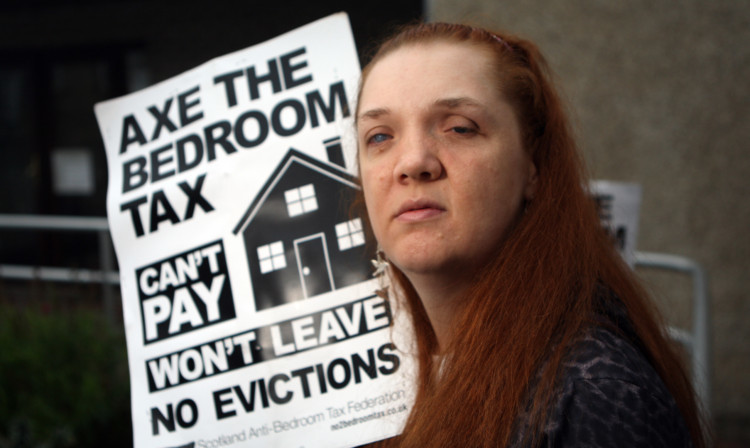Groundbreaking appeals against controversial bedroom tax decisions are under way in Fife.
Eight test cases challenging Fife Council’s decision to cut housing benefit in line with new UK Government legislation were brought before a tribunal in Kirkcaldy.
The hearings were the first in Scotland to dispute the contentious law and follow a number of appeals in Birmingham. Further tribunals will be held in Glasgow and North Lanarkshire later this week.
As anti-bedroom tax protesters gathered outside Pathhead Parish Church, where the appeals were heard throughout the day, independent tribunal chairman Simon Collins QC acknowledged the Government’s legislation was new and controversial, and said it would take time to get to grips with it.
Mr Collins added that the regulations were “harsh” but made it clear his job was not to take into account the effect they would have on tenants but to apply them according to the law.
The appeals followed the introduction of the policy, which has seen social tenants with more bedrooms than they are deemed to need having their housing benefit reduced.
Those with one extra room have had their benefit cut by 14%, while those with two or more extra rooms have suffered a 25% cut. Some 6,261 people are affected in Fife, along with 75,000 others across Scotland.
Louise McLeary, spokesperson for the Fife Anti-Bedroom Tax Campaign, was one of those to appeal against a 14% cut in her benefit.
Louise, who is blind, argued that the second bedroom in her specially-adapted home was used solely to house braille and specialist computer equipment and to give her guide dog a place to sleep.
Her lawyer Graeme Sutherland, from Fife Law Centre, said she had not asked for a two-bedroom house but had been allocated it following an assessment of need.
Adding that the legislation was vague, Mr Sutherland said the definition of a bedroom was not properly explained.
Pointing out that Miss McLeary receives assistance with shopping and housework from her landlord Kingdom Housing, Mr Sutherland said: “My submission is the claimant can’t do without the care she is provided with.
“It is absolutely essential for her and there is a legal obligation for the landlord to provide the care.
“This house has already been adapted. It would be a travesty if, because of the harsh application of these particular rules, she would be required to give this property up.”
Representing Fife Council, Les Robertson, of the finance and procurement service, argued Miss McLeary’s property did not fall into the exempt category.
“Kingdom Housing has confirmed this is a two-bedroom property,” he said.
“By applying the regulations, the council has no option but to apply the reduction in housing benefit.”
He added: “We are relying on landlords to accurately describe their properties. There is no definition of minimum bedroom size.”
However, Mr Collins said that was “slightly ambiguous”, adding: “It’s up to the local authority to make its own decision that the landlord has accurately described the property.
“Because this is an appeal, it is now for me to decide what a bedroom is. In this case, the council has made a decision based on the landlord’s description but hasn’t even gone round to inspect the room.”
Summing up, the QC added: “These are harsh regulations about which people may have legitimate grievance, but that’s not a matter for me.
“I have to decide what they mean and apply them. I hope you appreciate this is a new and controversial matter the tribunal needs to get to grips with.”
